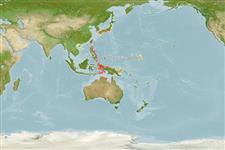Klassifizierung / Names
Namen | Synonyme | Catalog of Fishes(Gattung, Arten) | ITIS | CoL | WoRMS | Cloffa
>
Gobiiformes (Gobies) >
Microdesmidae (Wormfishes) > Ptereleotrinae
Etymology: Parioglossus: Greek, pareia = jaw + Greek, glossa = tongue (Ref. 45335); senoui: Named for Dr. H. Senou (KPM), in honor of his great contribution to our knowledge of systematics and distribution of the fishes of Japan..
Environment: milieu / climate zone / depth range / distribution range
Ökologie
seewasser riff-verbunden; tiefenbereich 0 - 1 m (Ref. 84007). Subtropical
Western Pacific: Japan and Palau.
Size / Gewicht / Alter
Maturity: Lm ? range ? - ? cm
Max length : 2.2 cm SL Männchen/unbestimmt; (Ref. 84007); 2.3 cm SL (female)
Kurzbeschreibung
Morphologie | Morphometrie
Rückenflossenstacheln (insgesamt): 7; Rückenflossenweichstrahlen (insgesamt): 13-14; Afterflossenstacheln 1; Afterflossenweichstrahlen: 12 - 14; Wirbelzahl: 26 - 27. This species differs from its congeners in having three pelvic-fin segmented rays (Ref. 84007).
This species forms schools around the bases of rock-islands in coral reef habitats at depths of about 20cm to 1 m (Ref. 84007).
Life cycle and mating behavior
Geschlechtsreife | Fortpflanzung | Ablaichen | Eier | Fecundity | Larven
Suzuki, T., T. Yonezawa and J. Sakaue, 2010. Three new secies of the ptereleotrid fish genus Parioglossus (Perciformes: Gobioidei) from Japan, Palau and India. Bull. Natl. Mus. Nat. Sci., Ser. A, (Suppl. 4):31-48. (Ref. 84007)
IUCN Rote Liste Status (Ref. 130435)
Bedrohung für Menschen
Harmless
Nutzung durch Menschen
Mehr Information
NamenSynonymeMetabolismusRäuberÖkotoxikologieFortpflanzungGeschlechtsreifeAblaichenSpawning aggregationFecundityEierEientwicklung
Alter/GrößeWachstumLänge-GewichtLänge-LängeLängenhäufigkeitenMorphometrieMorphologieLarvenLarven Pop.Dyn.RekrutierungDichteBRUVS
ReferenzenAquakulturAquakultur ProfilZuchtlinienGenetikElectrophoresesVererbbarkeitKrankheitenVerarbeitungNutrientsMass conversion
PartnerBilderStamps, Coins Misc.LauteCiguateraGeschwindigkeitSchwimmstilKiemenoberflächeOtolithsGehirngrößeSehfähigkeit
Tools
Zusatzinformationen
Download XML
Internet Quellen
Estimates based on models
Preferred temperature (Ref.
123201): 25.5 - 29.2, mean 28.8 °C (based on 583 cells).
Phylogenetic diversity index (Ref.
82804): PD
50 = 0.5000 [Uniqueness, from 0.5 = low to 2.0 = high].
Bayesian length-weight: a=0.00389 (0.00180 - 0.00842), b=3.12 (2.94 - 3.30), in cm total length, based on all LWR estimates for this body shape (Ref.
93245).
Trophic level (Ref.
69278): 3.1 ±0.4 se; based on size and trophs of closest relatives
Fishing Vulnerability (Ref.
59153): Low vulnerability (10 of 100).
